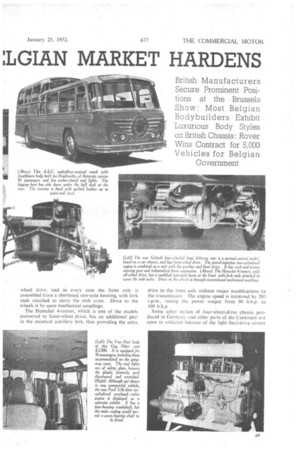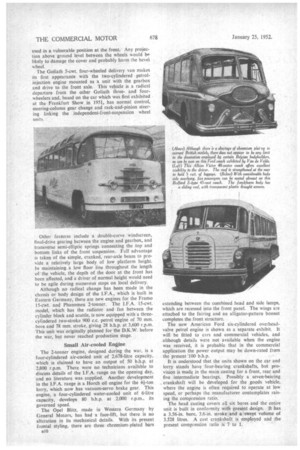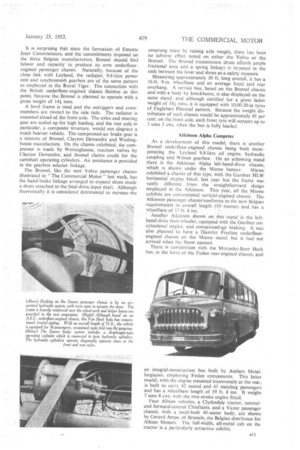BRITAIN'S 1GIAN MARKET HARDENS
Page 42

Page 43

Page 44

Page 45

If you've noticed an error in this article please click here to report it so we can fix it.
By L. J. COTTON, M.I.R.T.E.
APART from a Brossel underfloor-engined chassis, and numerous Belgian and German four-wheeldrive chassis, there were few vehicles with new technical interest at the Brussels Show, Even the coachbuilders have.moderated their body sty/es in conformity with contemporary Continental practice.
Perhaps of greatest importance to the Belgians was the news, released when the Show opened fast Saturday, that Brossel, Miesse and F.N. are combining to produce military vehicles, thus saving the importing of machines of this type from other countries. The Land-Rover is, moreover, to be built in Belgium. Five thousand LandRovers have been ordered by the Belgian Government, and although the first of these will be sent from Britain, they will subsequently be part-manufactured in the old Minerva works. Eighty per cent. of manufacture is planned to be carried out in Belgium.
In 1950, when sterling was devalued, Britain enjoyed a bumper year in exporting vehicles to Belgium, among other countries, but the immediate effects of devaluation have worn off, and the gap between British and American. French and German prices is now narrow. The imports of British commercial vehicles to Belgium were almost halved in 1951, whereas the purchases of French and German buses and lorries were higher,
Market May Improve
In the all-out drive to equip the military with vehicles, it is conceivable that the Belgian need for civilian models from outside the country will be increased this year, but with the keen competition from Europe and America, it will be a hard market. At the Show, many cases were cited of cars and vans being sold below list price, because the potential customer had played one distributor against another before buying. I was told that few low-priced cars were sold without some accessory being supplied free.
It is difficult, under such conditions, for British manufacturers to compete in the van and light goods class, because German and French makers appear to be determined to gain the market at all costs. In the sale of medium-weight goods chassis, however, there is• ample scope.for the British maker, especially where the.
vehieles•are equipped with oil engines. . Althotigh oil-engined models are penalized by 40 per B8
cent, higher tax, oil fuel costs approximately a third the price of petrol, and operators claim it is economic to use an oil engine in any vehicle running 25,000 miles yearly. The Perkins engine is by far the most popular in Belgium, and there are more than 30 shown at Brussels, either installed in vehicles or displayed on manufacturers' stands.
There is a need for a similar low-priced British oil engine of 90-100 b.h.p. output to compete with American and German units. An engine of this capacity would strengthen the British position in the 5-7-ton class of goods chassis, and in the medium-capacity coach field.
In Germany there are 10,000 ex-military all-wheeldrive vehicles in operation, and large numbers are in use in the surrounding countries. German makers are preparing to step into the. breach when the supply of these used vehicles is exhausted, and Henschel, M.A.N., Krupp Sudwerke and Magirus •Deutz have four-wheeldrive vehicles prominently displayed at Brussels. .These are all standard chassis modified to incorporate front wheel drive, and in every ease the front axle is assembled from a shortened rear-axle housing, with fork ends attached to carry the stub arms. Drive to the wheels is by open mechanical couplings.
The Henschel ,l-lonner, which is one of the models converted to front-wheel drive, has an additional gear in the standard auxiliary box, thus providing the extra
drive to the front axle without major modifications to the transmission. The engine speed is increased by 200 r.p.m., raising the power output from 90 b.h.p. to 100 b.h.p.
Some other makes of four-wheel-drive chassis produced in Germany and other parts of the Continent arz open to criticism because of the light final-drive covers used in a vulnerable position at the front. Any projection above ground level between the wheels would be likely to damage the cover and probably harm the bevel wheel.
The Goliath 5-cwt. four-wheeled delivery van makes its first appearance with the two-cylindered petrolinjection engine mounted as a unit with the gearbox and drive to the front axle. This vehicle is a radical departure from the other Goliath threeand fourwheelers and, based on the car which was first exhibited at the Frankfurt Show in 1951, has normal control, steering-column gear change and rack-and-pinion steering linking the independent-front-suspension wheel units.
Other feafures include a double-curve windscreen, final-drive gearing between the engine and gearbox, and transverse semi-elliptic springs connecting the top and bottom links of the front suspension. Full advantage is taken of the simple, cranked, rear-axle beam to provide a relatively large body of low platform height. In maintaining,a low floor line throughout the length of the vehicle, the depth of the door at the front has been affected, and a driver of normal height would need to be agile during numerous stops on local delivery.
Although no radical change has been made in the chassis or body design of the 1.F.A., which is built in Eastern Germany, there are new engines for the Framo 15-cwt. and Phanomen 2-tonner. The 1.F.A. 15-cwt. model, which has the radiator and fan between the cylinder block and scuttle, is now equipped with a threecylindered two-stroke 900 c.c, petrol engine of 70 mm. bore and 78 mm. stroke, giving 28 b.h.p. at 3,600 r.p.m. This unit was originally planned for the D.K.W. before the war, but never reached production stage.
Small Air-cooled Engine
The 2-tonner engine, designed during the war, is a four-cylindered air-cooled unit of 2.678-litre capacity, which is claimed to have an output of 50 b.h.p. at 2,800 r.p.m. There were no technicians available to discuss details of the I.F.A. range on the opening day, and no literature was supplied. Another development in the I.F.A. range is a Horeb oil engine for the 4i-ton lorry, which now has vacuum-servo brake gear. This engine, a four-cylindered water-cooled unit of 6-litre capacity, develops 80 b.h.p. at 2,000 r.p.m., its governed speed.
The Opel Blitz, made in Western Germany by General Motors, has had a face-lift, but there is no alteration in its mechanical details. With its present frontal styling, there are three chromium-plated bars atO extending between the combined head and side lamps, which are recessed into the front panel. The wings are attached to the fairing and an alligator-pattern bonnet completes the front structure.
The new American Ford six-cylindered overheadvalve petrol engine is shown as a separate exhibit. It will be fitted to cars and commercial vehicles, and although details were not available when the engine was received, it is probable that in the commercial application the power output may be down-rated from the present 100 b.h.p.
It is understood that the units shown on the car and lorry stands have four-bearing crankshafts, but provision is made in the main casting for a front, rear and five intermediate bearings. Possibly a seven-bearing crankshaft will be developed for the goods vehicle, where the engine is often required to operate at low speed, or perhaps the manufacturer contemplates raising the compression ratio.
The head casting covers all six bores and the entire unit is built in conformity with present design. It has a 3.56-in. bore. 3.6-iri. stroke" and a 'swept volume of 3.528 litres. A cast crankshaft is employed and the present compression ratio is:7 to 1.
It is surprising that since the formation of Entente Inter Constructeurs, and the commitments imposed on the three Belgian manufacturers, Brossel should find labour and capacity to produce its own underfloorengined passenger chassis. Naturally, because of the close link. with Leyland, the radiator, 9.8-litre power unit and synchromesh gearbox are of the same pattern as employed in the Royal Tiger. The connection with the British underfloor-engined chassis finishes at this point, because the Brossel is planned to operate with a gross weight of 14} toris. • A level frame is used and the outriggers and crossmembers are riveted to the side rails. The radiator is mounted ahead of the front axle. The axles and steering gear are scaled up for high loading, and the rear axle in particular, a composite structure, would not disgrace a much heavier .vehicle. The compressed-air brake gear is a mixture of Brossel, Clayton Dewa,ndre and Westinghouse manufacture. On the chassis exhibited, the compressor is made by Westinghouse, reaction valves by Clayton Dewandre, and Brossel claims credit for the camshaft operating cylinders. Air assistance is provided in the gearbox selector linkage.
The Brossel, like the new Volvo passenger chassis illustrated in "The Commercial Motor" last week, has the hand-brake linkage arranged to expand shoes inside a drum attached to the final-drive input shaft. Although theoretically it is considered detrimental to increase the unsprung mass by raising axle weight, there has been no adverse effect noted on either the Volvo or the Brossel. The Brossel transmission drum affords ample frictional area and a spring linkage is imposed in the rods between the lever and shoes as a safety measure.
Measuring approximately 30 ft. long overall, it has a 16-ft. 9-in, wheelbase and an average front and rear overhang. A service bus, based on the Brossel chassis and with a body by Joncicheere, is also displayed on the same stand, and although certified for a gross laden weight of 14,. tons, it is equipped with 10.00-20-in tyres of Englebert Plimetal pattern. Because the weight distribution of such chassis would be approximately 45 per cent, on the front axle, each front tyre will support up to 3 tons 5 cwt. when the bus is fully loaded.
Atkinson Alpha Competes As a development of this model, there is another 13rossel underfloor-engined chassis being built incorporating the Leyland 9.8-litre oil engine, hydraulic coupling and Wilson gearbox. On an adjoining stand there is the Atkinson Alpha left-hand-drive chassis,
which is shown under the Miesse banner. Miesse exhibited a chassis of this type, with the Gardner HLW horizontal engine fitted, last year but the frame was vastly different from the straightforward design employed in the Atkinson. This year, all the Miesse exhibits are conventional vertical-engined chassis. The Atkinson passenger chassis.tonforms to the new Belgian requirements in overall length (10 metres) and has a wheelbase of 17 ft. 6 ins.
Another Atkinson shown on this stand is the -lefthand-drive four-wheeler, equipped With the Gardner sixCylitidered engine, and compressed-air braking. It was also planned to have a Daimler Freeline underffoorengined chassis on the Miesse stand, but it had not arrived when the Show opened.
There is competition with the Mercedes-Benz Heck bus, in the form of the Foden rear-engined chassis, and an integral-construction bus built by Ateliers Metallurgiques, employing Foden components. This latter model, with the engine mounted transversely at the rear, is built to carry 42 seated and 43 standing passengers and has a wheelbase length of 19 ft. 8 ins. It weighs 7 tons 8 cwt. with the two-stroke engine fitted.
Four Albion vehicles, a Clydesdale tractor, normaland forward-control Chieftains, and a Victor passenger chassis, with a local-built 40-seater body, are shown by Gerard Ampe. of Brussels,. the Belgian distributor for Albion Motors. The full-width, all-metal cab on the tractor is a particularly attractive exhibit.




















































































